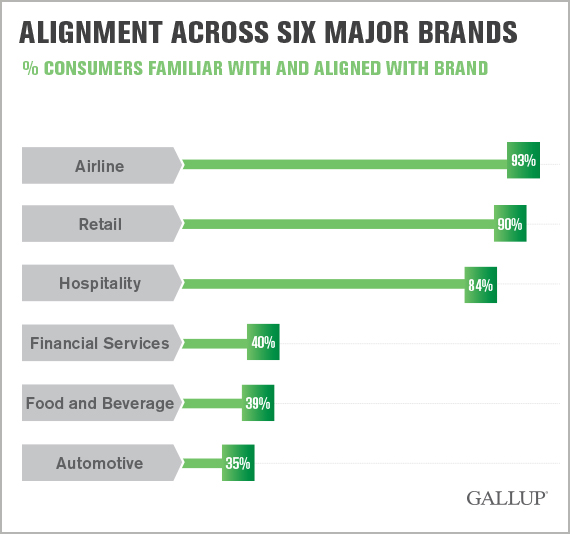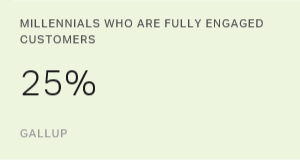Consumers want to walk into a store, go online, or contact a customer care center and have the experience they were promised.
Advertising remains big business in the United States. According to Kantar Media, U.S. companies spent a combined $140 billion on promotion and publicity in 2013 alone.
That hefty sum buys a lot of messaging -- from 60-second television spots and half-page newspaper ads to digital billboards and mobile marketing. Today's consumers are constantly bombarded by advertisements from companies claiming their product is better than the rest. But in a marketplace still struggling to recover from the financial collapse of 2008 and the ensuing Great Recession, it takes a lot more than a catchy tagline and a slick commercial to engage consumers.
Alignment -- not advertising -- brings greater rewards
Following the financial crisis, consumers began to lose trust in companies, especially in big businesses and the executives who run them. And that trust has been slow to come back. In June 2013, for example, a Gallup poll revealed that only 22% of Americans had a great deal or quite a lot of confidence in big business.
Companies often believe that they can change consumers' perceptions of their brand by embarking on big advertising and marketing campaigns. They use updated logos and celebrity spokespeople to signify changes in their attitudes and behaviors.
But these tactics simply promote a message; they do not deliver what consumers really value -- an actively aligned brand promise. Consumers want to walk into a store, go online, or contact a customer care center and have the experience they were promised. They want companies to back up their taglines and follow through on their guarantees. When companies do this, consumers will align themselves with those brands -- and ultimately, will trust them.
Creating brand alignment is powerful and meaningful in a way that traditional methods of attracting and retaining customers -- like marketing and advertising -- are not. Gallup research reveals that when consumers are aligned with a brand, they give it twice as much share of wallet as those who are not aligned with that same brand. It can be difficult for consumers to fully trust in a brand and align themselves with it, but when they do, they reward it generously.
Brand promises are hit and miss
Brand alignment is worth a lot. But to get there, consumers must first understand what a company stands for. Ideally, they should be able to verbalize the principal characteristics of an organization's brand promise. A brand promise is not a mission statement, but a brief summary of a company's most distinguishing characteristics that consumers find compelling and credible. Gallup finds that though some companies have been incredibly successful at positioning themselves with consumers, others have largely missed the mark.
In one study, Gallup asked more than 6,600 consumers who were familiar with but not necessarily customers of six major American brands to answer this question: "How would you describe what Brand X represents, and what makes it different from its competitors?" To determine the degree of alignment, their responses were compared with a list of core identity elements for each brand.
Across the six brands -- representing the airline, retail, hospitality, financial services, food and beverage, and automotive industries -- only the airline and the major retailer had alignment at or above 90% among consumers who were already familiar with their brands. For the other brands, the degree of alignment was much lower. The automotive brand, for example, experienced 35% alignment among consumers familiar with it. This implies that some companies have brand promises that may be too weak or vague to effectively connect with consumers.

Few employees can communicate their company's brand promise
A strong brand promise is a differentiator, but it can quickly become meaningless to consumers if it is not backed up. Companies must rely on their employees to understand and deliver on the brand promise and bring it to life for their customers. But most companies fail to equip their employees with the necessary knowledge and resources to be effective brand ambassadors. According to Gallup research, less than half of managers (46%) and slightly more than one-third of non-management employees (37%) strongly agree with the statement "I know what my company stands for and what makes our brand(s) different from our competitors."
Companies exhaust millions of dollars developing and communicating their brand promises to consumers, but these findings suggest that many are overlooking the very people responsible for carrying out those promises. And that is a big misstep -- one with severe implications for a company's brand. If employees do not understand their company's identity and what sets it apart, it is unlikely that customers will either. If employees do not have a clear idea of their company's brand promise, it is unlikely they will be able to deliver it to customers.
Consumers approach most brands -- and their promises -- with a healthy dose of skepticism. But Gallup finds that companies that "walk the talk" have a significant advantage in the competition for consumer trust. Consumers align themselves with a company when they can recognize its brand promise and trust in its ability to keep that promise.
Almost every company has a brand promise that tells consumers what they can expect from their interactions with that company. However, Gallup finds that not every company has done an effective job of creating and communicating a strong brand promise. And to create brand alignment, companies must develop a strong brand promise to let consumers know what the company stands for, what makes it unique, and why they should choose it over its competitors.
Craft a culture that promotes the brand
Because companies rely on employees to represent their brands every day and to execute on the brand promise, businesses should be devoting as much time, money, and energy to building their brands internally as they do externally. Television commercials and mobile ads are fleeting. If consumers notice them at all, they will most likely forget about them 10 seconds later.
Consumers are much more likely to remember and return to a brand based on their experience with it. And employees -- not advertising -- define those experiences. All employees, whether they are on the front line or behind the scenes, are key to a company's ability to deliver on its brand promise. They must understand the core elements of their company's brand identity and promise and accurately and readily verbalize it.
Clear leadership communication about a company's brand promise is a key element in helping employees create and deliver on that promise. But there are other crucial elements in shaping a culture that consistently delivers the brand promise.
The company's declared values and rituals must support the brand and connect employees to the brand in their daily work. Human capital practices -- such as attracting, selecting, developing, and engaging employees -- also must enable employees to deliver the brand promise. Work teams must be structured to make serving and engaging customers their most important goal, especially if customers typically interact with more than one employee.
Last but not least, performance systems -- from goals and accountability to reward and recognition -- should be clearly aligned to deliver the brand promise. When aligned, these five key drivers of culture -- leadership communication, values and rituals, human capital practices, work teams, and performance systems -- have the power to enable an organization to consistently and intentionally provide customers with a unique brand experience.
A brand is more than a logo or tagline. Though advertising and marketing initiatives are important, they must be in line with how an organization actually delivers its products and services. Even the most creative and innovative brand strategy is bound to fail if the company cannot execute on it. Brand alignment builds trust -- and trust is a necessary precursor to any company's long-term success.
